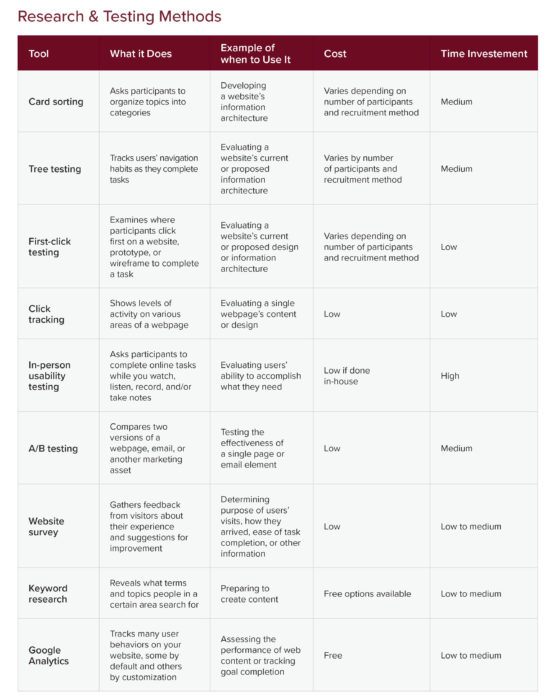Find out what questions to ask, tools to use, and resources to explore to get in your users’ heads.
Well-informed, user-centric digital marketing helps your audiences feel comfortable and confident in choosing your organization for their care, employment, or charitable giving. It improves goal completion, engagement, and ultimately, your health system’s bottom line.
So before you launch a service-line promotional campaign, redesign your website, or start a blog, consider information such as:
- Who your users are: Get relevant demographic information like age, gender, location, education level, disabilities, socioeconomic status, etc. Don’t forget to think about people close to those you’re trying to capture, like spouses or caregivers.
- Who influences them: Who are the biggest decision makers in your users’ lives? Should you target your marketing efforts to the loved ones of potential patients in addition to — or even instead of — the patients themselves?
- What they want: Your users’ content needs to override what your organization thinks is important. What’s motivating your users? Is that pressure positive or negative? What are their end goals — not just the task they want to complete on the website, but what they want to accomplish as a result of that task, like improving their health or community?
- What they’re afraid of: Healthcare almost always involves uncertainty. What specific concerns do audiences have about your topic? What or who is fueling those anxieties?
- What their obstacles are: Are the roadblocks tangible, like language barriers, disabilities, or lack of time? Or less tangible, like community taboo around a particular medical service? Who or what can help users overcome this obstacle?
- How they act: What tools do users prefer to engage with your web content? How much time do they spend with it? What are they searching for?
Empathy can help you start thinking of answers to some of these questions. But answering most of them requires some combination of market research, user research, and user testing. And since data is only as good as the process used to get it, you must choose the right sources and tools for your particular needs.
How to Get Information
You’ll understand your users best when you use both of these types of research:
- Quantitative – Numerical, measurable data
- Qualitative – Information that’s not numerical, like opinions and emotions
You’ll find no shortage of resources to help you find both quantitative and qualitative information at every stage of a digital marketing initiative—from brainstorming topics to refining navigation labels to tracking clicks. Your marketing agency or web partner can guide you to the right tools for your specific project, goals, and budget, and help you interpret the results.
Research & Testing Methods
Here are some tools Geonetric uses to help healthcare systems improve consumer engagement on the web:
Recruiting Participants
Whenever you’re testing a website or campaign content with real people, try to recruit the types of participants your marketing initiative is targeting. (That means not just your colleagues down the hall!)
To gather initial interest, try placing an ad, posting on social media, or using an existing email list. After getting a pool of volunteers, narrow it down to a manageable number that will provide the depth and breadth of results you want. You might filter according to demographic information, or do a phone screening to gauge things like familiarity with your organization and website. Consider also attending a Patient & Family Advisory Council meeting, if you have such a group, to explain your project and ask members to participate. Whatever methods you choose, reward participants for their time by offering to put their name in a drawing for a gift card or another prize.
Industry Research
In addition to custom user testing and research, you can also make your digital marketing more effective with industry research into broad user trends. Nielsen Norman Group shares results and insights from their wealth of usability and user experience studies on topics like eye tracking, intranets, mobile design, navigation, young users, and much more. Consider NRC Health for healthcare industry research and surveys (available for a fee). And for basic demographic information in your area, check the U.S. Census Bureau and University of North Carolina’s Health Literacy Data Map, which shows literacy levels by county across the country.
Patient Perspectives
If your marketing initiative focuses on patients, you have a few options for gathering additional qualitative data. Your organization may have support groups for people with certain medical conditions. Ask to meet with the organizers and/or members to learn more about their needs, concerns, and goals to discover how your digital marketing efforts can better help people in their situation. These members could form the basis of a focus group — a small-group discussion you moderate and record. Invite a colleague to take notes so you can focus on facilitating the conversation. If you’d prefer to discuss topics in greater detail with each person, consider individual (consumer) interviews instead. This approach can especially help you better understand the patient journey.
If focus groups or interviews aren’t an option, explore online communities for the patients and families you’re targeting. Patients Like Me has forums for many medical conditions, where you can read the questions, frustrations, and successes members have throughout their treatment journey. Many nationwide organizations, like the American and American Cancer Society, also have online communities open to anyone who creates an account. And Facebook has a wealth of groups and pages related to medical conditions and treatments — virtual hangouts where people express thoughts even more openly than they may in person.
If you’d like to ask questions, first check whether a particular online community has rules about posts from journalists, marketers, or people other than patients and families. And ask with sensitivity, explaining how responses could ultimately help other people with a certain medical condition.
Consolidate & Visualize Your Information
Once you have a foundational understanding of your users as a whole, consider using what you’ve learned to develop personas. These fictional, research-based representations of your audience can help you visualize and empathize with users and better understand the customer journey. When making your online marketing plan, you may find it easier to keep in mind a few well-developed personas than a mass of data. Use them to motivate and guide content strategy, writing, and design.
Examples of User Research Success
Mercy Medical Center in Cedar Rapids, Iowa, is one organization that saw firsthand the impact of user research and testing. When the organization learned web users were highly interested in information about urgent care, Mercy made the content more prominent. That simple change tripled visits to urgent care webpages, including the eArrival online check-in service.
Cone Health in Greensboro, NC, also saw impressive results from user behavior analysis and testing. After updating its brand promise, purpose, and vision, the organization reimagined its website to reflect its new priorities — and better engage users. Click tracking, analytics review, and user testing led to better-performing content, including a high-priority “Compare Your Care Options” page whose views increased 112%.
The Norwegian Cancer Society also adjusted their website content to prioritize what users identified as their top tasks. Rather than devoting banner ads and homepage space to users’ low-priority task of donating, the society promoted giving opportunities in more-strategic places — like content about research and funding needs. As a result, the organization recorded a 70% increase in one-time donations and 88% increase in monthly donors registered.
Want to see results like these for your organization? Contact us for help getting started.



